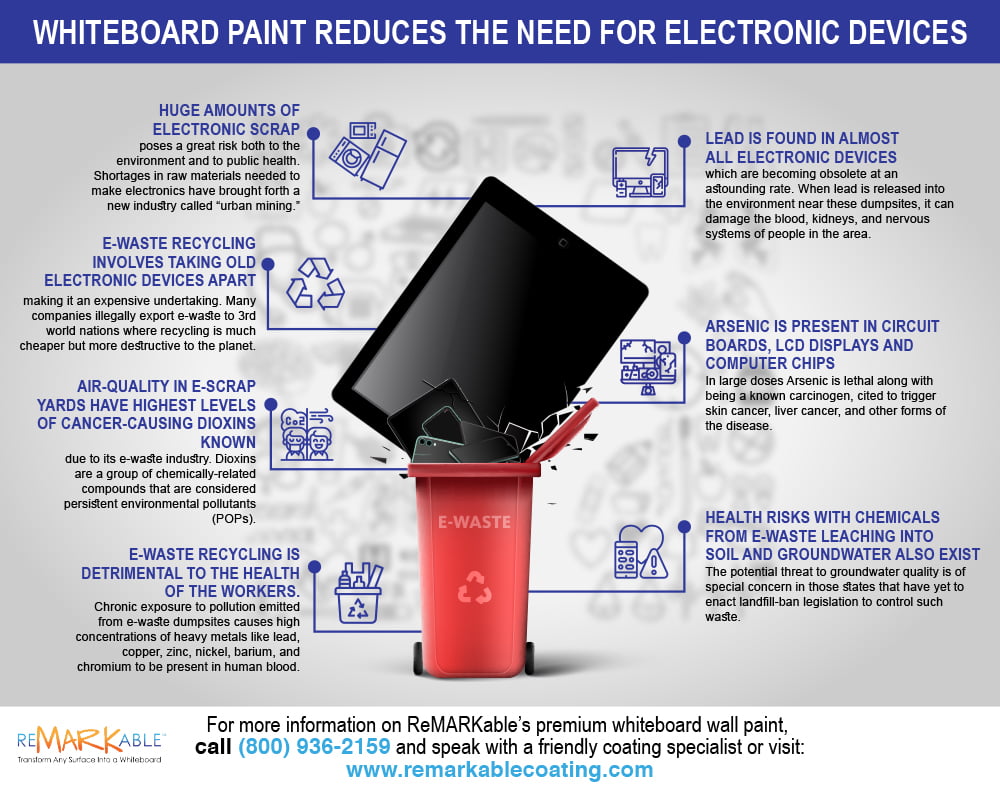
Whiteboard Paint Reduces the Need for Electronic Devices
Of the many environmental benefits of applying ReMarkable dry erase paint, one of the greatest is that it reduces the use of electronic products such as tablets and laptops, which generate an enormous quantity of waste that has devastating effects on Earth’s environment. As the amount of e-waste dramatically increases year by year, solutions for its proper recycling have lagged far behind. Although it is essential to give e-waste items to a certified recycling company that meets strict requirements for handling these materials, many individuals and businesses fail to do so. Their old electronics end up in landfills, producing toxic results for our air, water, and soil. The main hazardous substances to be found in discarded electronic products are lead, mercury, cadmium, zinc, yttrium, chromium, beryllium, nickel, brominated flame retardants, antimony trioxide, halogenated flame retardants, tin, polyvinyl chloride (PVC), and phthalates. The presence of these and other toxins in our planet’s ecosystem can be greatly reduced through the use of whiteboard-painted walls in place of electronic devices.
Huge amounts of electronic scrap
poses a great risk both to the environment and to public health. Shortages in raw materials needed to make electronics have brought forth a new industry called “urban mining.”
The start of the 21st century has witnessed the generation of huge amounts of electronic scrap, whose careless recycling in both developed and developing nations poses a great risk both to the environment and to public health. As more people buy electronic gadgets, manufacturers are starting to experience shortages of the raw materials needed to make their products, so reclaiming and reusing the constituents of discarded e-products, called “urban mining,” makes good financial sense. A recent study conducted in China revealed that traditional mining of copper, gold, silver, and aluminum from ore is 13 times more costly than recovering these metals through the urban mining of electronic waste.
E-waste recycling involves taking old electronic devices apart
making it an expensive undertaking. Many companies illegally export e-waste to 3rd world nations where recycling is much cheaper but more destructive to the planet.
Proper or formal e-waste recycling typically involves taking old electronic devices apart, separating and categorizing their contents by material, and then cleaning them. Items are then mechanically shredded for further sorting through the use of advanced separation equipment. Companies that perform this service must adhere to strict health and safety guidelines and use pollution-control technologies that reduce the environmental and public health hazards of handling e-waste. All these procedures make formal recycling an expensive undertaking. As a result, many companies and countries illegally export their e-waste to developing nations where recycling methods are more cost-effective but also much more destructive to the planet.
In the unindustrialized nations where much of this illegal e-waste processing occurs, air pollution levels and concentrations of heavy metals are especially high around so-called “recycling plants,” as compared to other regions. These sites are typically backyard operations where impoverished local residents process the obsolete electronics by hand, separating them into parts to extract valuable metals such as gold, silver, and copper before disposing of the rest in landfills. Some metals and plastics are melted down, and those materials that can’t be feasibly processed accumulate in massive dumps near inhabited places and waterways. Sometimes, toxic fumes are inhaled directly as metals from the parts are burned in open bonfires.
Air-quality in e-scrap yards have highest levels of cancer-causing dioxins known
due to its e-waste industry. Dioxins are a group of chemically related compounds that are considered persistent environmental pollutants (POPs).
A typical site where these crude e-waste recycling methods are used is a cluster of villages in southeastern China known as the world’s largest dumping ground for electronic scrap from the United States. There local villagers remove solder from circuit boards over coal-fired grills, burn plastic casings from wires to extract the copper, silver, and mine gold by soaking computer chips in pools of hydrochloric acid. An air-quality study conducted in the area found that it had some of the highest levels of cancer-causing dioxins in the world due to its e-waste industry. Dioxins are a group of chemically related compounds that are considered persistent environmental pollutants (POPs).
Dioxins are found around the globe in local ecosystems, where they accumulate in the food chain, mainly in the fatty tissue of animals. These chemicals are highly toxic and can cause reproductive and developmental issues, damage the immune system, interfere with the action of hormones, and cause cancer. Due to their potentially lethal nature, prevention or reduction of human exposure is best accomplished through direct measures, such as strict control of e-waste recycling processes to reduce the production of dioxins. Another approach is the application of ReMARKable whiteboard painted walls in schools, offices, and other facilities to reduce the use of electronic devices, which are some of their main sources.
E-waste recycling is detrimental to the health of the workers
Chronic exposure to the pollution emitted from e-waste dumpsites causes high concentrations of heavy metals like lead, copper, zinc, nickel, barium, and chromium to be present in human blood.
For the above-mentioned reasons, the current global recycling system is detrimental to the health of the workers who improperly handle e-waste without protection from dangerous materials and is also a direct cause of contamination in the surrounding environment. Chronic exposure to the atmospheric pollution emitted from e-waste dumpsites causes high concentrations of heavy metals such as lead, copper, zinc, nickel, barium, and chromium to be present in human blood and may be related to hypertension, abnormally low levels of blood oxygen, and other conditions in people working in or living near the sites. The trigger for the air-polluting effect of e-waste is the fact that when the material is heated by overexposure to the sun, for instance, these metals along with other toxic chemicals are released into the atmosphere, causing one of e-waste’s most harmful effects.
Lead is found in almost all Electronic devices
which are becoming obsolete at an astounding rate. When lead is released into the environment near these dumpsites, it can damage the blood, kidneys, and nervous systems of people in the area.
Regarding lead, almost all electronics contain it, and today these devices are growing in number and becoming obsolete at an astounding rate. When discarded, some of our most advanced technological devices represent rapidly expanding and often unregulated exposure to this highly poisonous metal, which plagued even the ancient Romans. A University of Florida environmental scientist recently studied the ecological impact of the lead found in 12 different types of electronic items commonly discarded in landfills. In a report sponsored by the U.S. Environmental Protection Agency (EPA), he presented his finding that the items leached lead at concentrations above the EPA threshold for categorizing a type of waste as hazardous. When released into the environment near these dumpsites, lead can damage the blood, kidneys, and nervous systems of people in the area.
Arsenic is present in circuit boards, LCD displays, and computer chips
In large doses, arsenic is lethal along with being a known carcinogen, cited to trigger skin cancer, liver cancer, and other forms of the disease.
The air around e-waste dumps is also high in arsenic, various acids, and other potentially toxic chemicals, including mercury and brominated flame retardants. Concerning arsenic, the reckless disposal of e-waste constitutes one of the most common sources of the inorganic form of this poison. Arsenic is present in circuit boards, LCD displays, computer chips, and other electronic components, and as these parts accumulate in landfills, the arsenic present seeps into the surrounding land, affecting its soil chemistry and possibly the contents of groundwater as well. The presence of arsenic in groundwater and soil has varying effects on different organisms and may be harmful to both land and sea animals. In humans, ingesting arsenic in low doses causes irritation of the digestive system, and in large doses, it’s lethal. Arsenic is also a known carcinogen, being cited as a trigger for skin cancer, liver cancer, and other forms of the disease.
Health risks with chemicals from e-waste leaching into soil and groundwater also exist
The potential threat to groundwater quality is of special concern in those states that have yet to enact landfill-ban legislation to control such waste.
Another common method of e-waste disposal is to simply burn the unusable parts after sorting. Introducing arsenic into the atmosphere in this way also has serious implications for human and animal health. For example, research by the National Cancer Institute has shown a linear relationship between inhaling arsenic and the development of lung cancer, as well as a wide range of nervous disorders. Although many states in the US have enacted landfill bans for most consumer electronics and appliances, the dangers associated with the chemicals from e-waste leaching into soil and groundwater remain. The potential threat to groundwater quality is of special concern in those states that have yet to enact landfill-ban legislation to control such waste.
Considering the many harmful environmental consequences related to electronic waste disposal, choosing economical, long-lasting, and eco-friendly ReMARKable Whiteboard Paint is a sensible alternative for all types of applications since it minimizes the need for laptops, tablets, and other devices, providing a highly flexible medium for conveying information and ideas in offices, schools, and other settings.


























































































![ReMARKable’s Winter Sale is Here! [25% Off + Free Shipping]](https://www.remarkablecoating.com/wp-content/uploads/2018/01/Red-Tag-Winter-Fashion-Facebook-Post-1-440x264.png)















![Drive Your Organization Into Openness and Watch it Expand [20% Off Whiteboard Paint]](https://www.remarkablecoating.com/wp-content/uploads/2016/04/Drive-Your-Organization-Into-Openness-and-Watch-It-Expand.-1-440x264.jpg)

![30% Off St Patrick’s Day Sale! [Details Inside]](https://www.remarkablecoating.com/wp-content/uploads/2016/03/Glorious-1-440x264.png)


![Giant Leaps Forward Require Big Spaces. [Leap Year Sale Event!]](https://www.remarkablecoating.com/wp-content/uploads/2016/02/Giant-Leaps-ForwardRequire-Big-Spaces-440x264.jpg)

















![ReMARKable Summer Sale 2018 [28% Off Whiteboard Paint]](https://www.remarkablecoating.com/wp-content/uploads/2018/06/Blue-Simple-Line-Beach-Facebook-Post-1-440x264.png)










































































































































































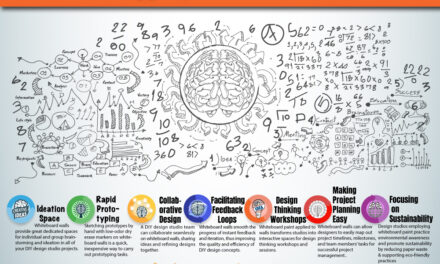



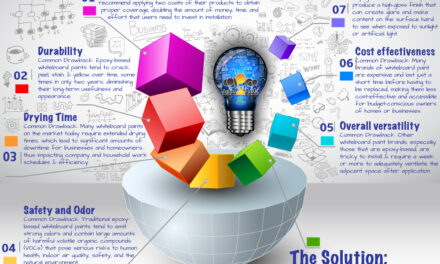

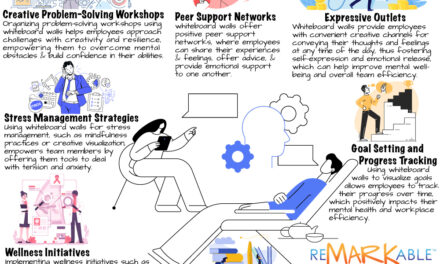


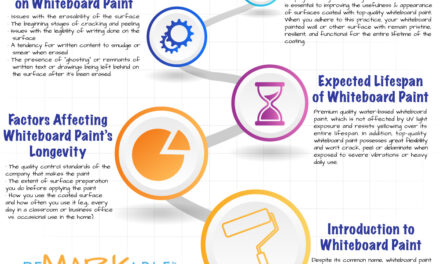
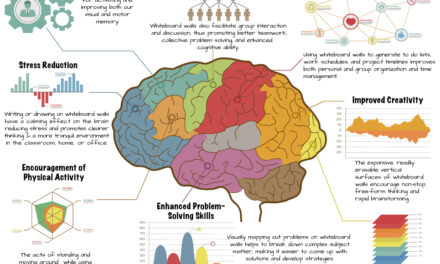



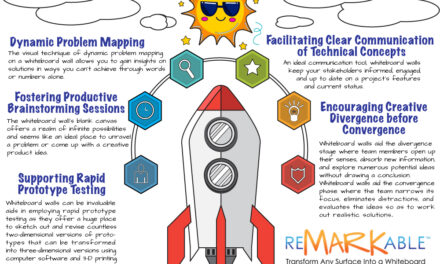



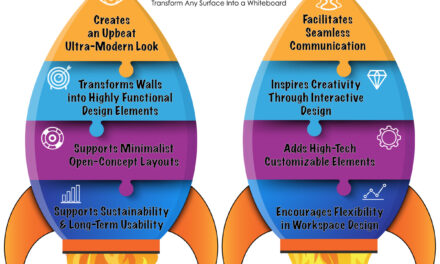









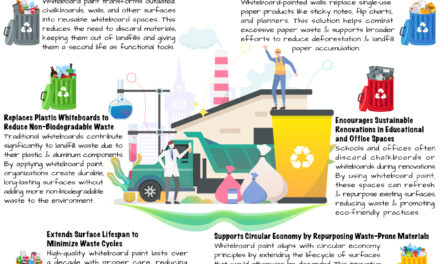







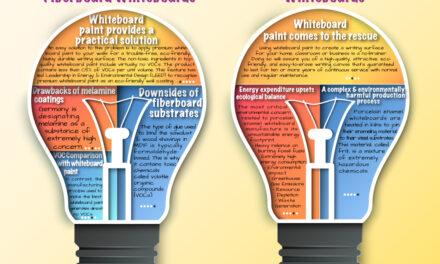










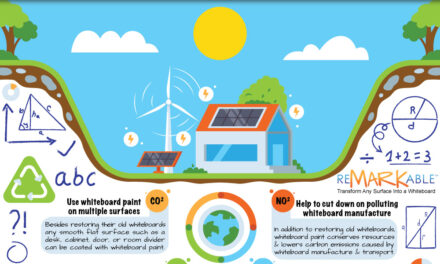
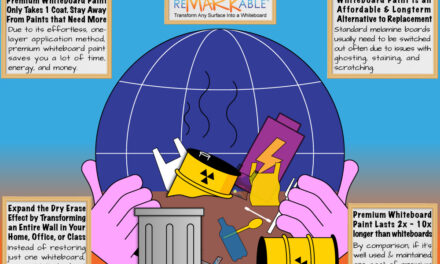







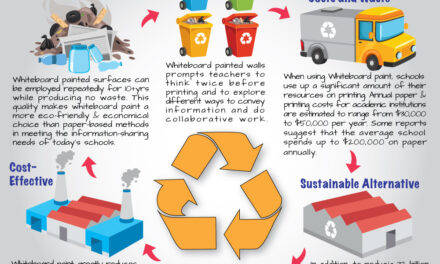
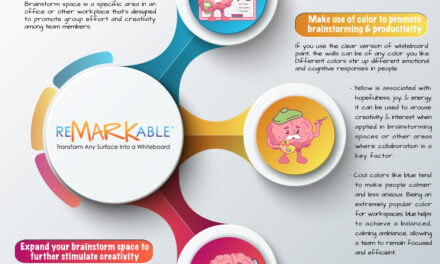

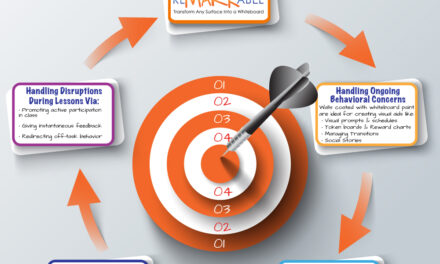
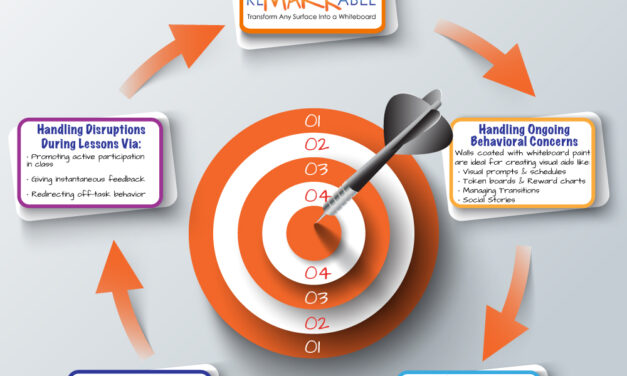

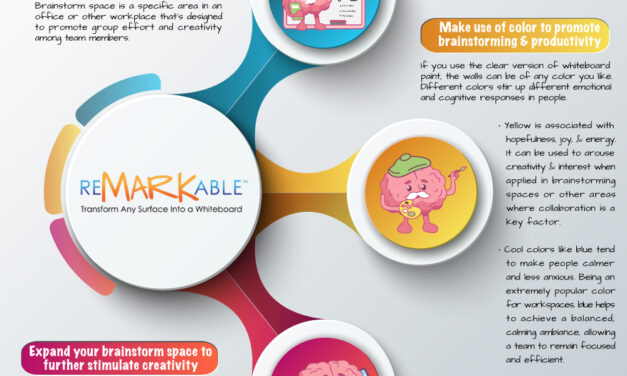










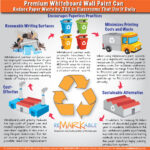

0 Comments